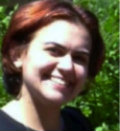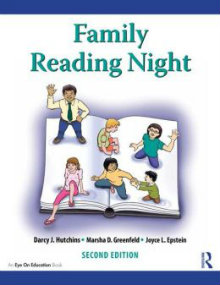A Book to Enliven Family Reading Night
Family Reading Night, 2nd Edition
By Darcy J. Hutchins, Joyce L. Epstein and Marsha D. Greenfeld
(Routledge, 2015 – Learn more)

The second edition of Family Reading Night by Darcy J. Hutchins, Marcia D. Greenfeld and Joyce L. Epstein is a practical, idea-filled guide for educators hosting Family Reading Nights.
Although there are a few mentions of middle grades in the introduction – “Middle level educators in grades 6-8 may use, extend, and adapt the ideas in this book for Family Reading Nights that match the reading and language arts skills in their curricula” (5) – this book is squarely aimed at primary and intermediate Family Reading Night coordinators.

Family Reading Nights are typically events organized and hosted by a school community to share enjoyable reading and literacy activities with families. As described in the first chapter, additional purposes are for families to learn about the reading and literacy curriculums at school, to engage parents who may not usually participate in school activities, and to increase students’ literacy skills.
All the details to plan and implement your Family Reading Night
The remainder of the first chapter contains practical suggestions for implementing Family Reading Nights, including the makeup of the planning committee; a variety of format options for an evening; and suggestions of specific practices known to encourage families to attend, such as serving dinner, showcasing student performances, engaging activities, publicity, attendance incentives, and child care.
The Family Reading Nights described throughout this book are designed for two-hour gatherings, where the first hour includes a whole group activity, food, and student performances and the second is for small group or breakout sessions. Typical challenges are addressed as well as numerous details that should be considered before an actual Family Reading Night. The ten Common Core State Standards for reading are summarized as well.
Monthly themes with student presentations, whole group activities, and more
Each chapter describes a theme, suggested materials, skills targeted (although they are not in CCSS language), a whole group activity, student presentation ideas, and breakout sessions for both primary and intermediate students so an entire elementary school could participate on a single theme. There are also reproducibles, Family Pages for parents and students to work on together, and suggested classroom follow-up activities. Throughout, the authors emphasize flexibility and appropriate adaptations to students’ and families’ needs and interests.
Some of the monthly themes are expected: scary stories in October, Dr. Seuss in March, poetry in April; but others are novel and welcome, such as well-loved books in September, reading Olympics in January, and biographies in May. Activities and instructions are no longer than a page, making reproducing and distributing them convenient. Activities are accessible and mostly open-ended to ensure success. Connections with actual texts are emphasized and could lead to further family or classroom reading. There are plentiful ideas and options within each month to keep families engaged and entertained, and creative planners could make adjustments to keep activities fresh year after year.
An appendix filled with Spanish translations
The authors include two appendixes, one with forms for planning Family Reading Nights and one with Spanish translations of all of the family activities described. All of the activities can be downloaded in English or Spanish from the publisher’s website as well.
Family Reading Night is full of useful ideas and would be a worthwhile addition to the professional development collection of an elementary school, but the immediate practicality for middle-level educators is limited; the examples, suggestions, and themes could serve as inspirations for middle grade Family Reading Nights, but alterations would be necessary.
Mara Southorn has been a reading specialist at Hill Middle School in Naperville, Illinois, for ten years. Prior to that, she taught high school reading and English in Colorado. She has master’s degrees from the Reading Specialist program at Teachers College, Columbia University, and the Graduate School of Library and Information Science at the University of Illinois. Her goal is to help students become independent readers, writers, and thinkers.



































